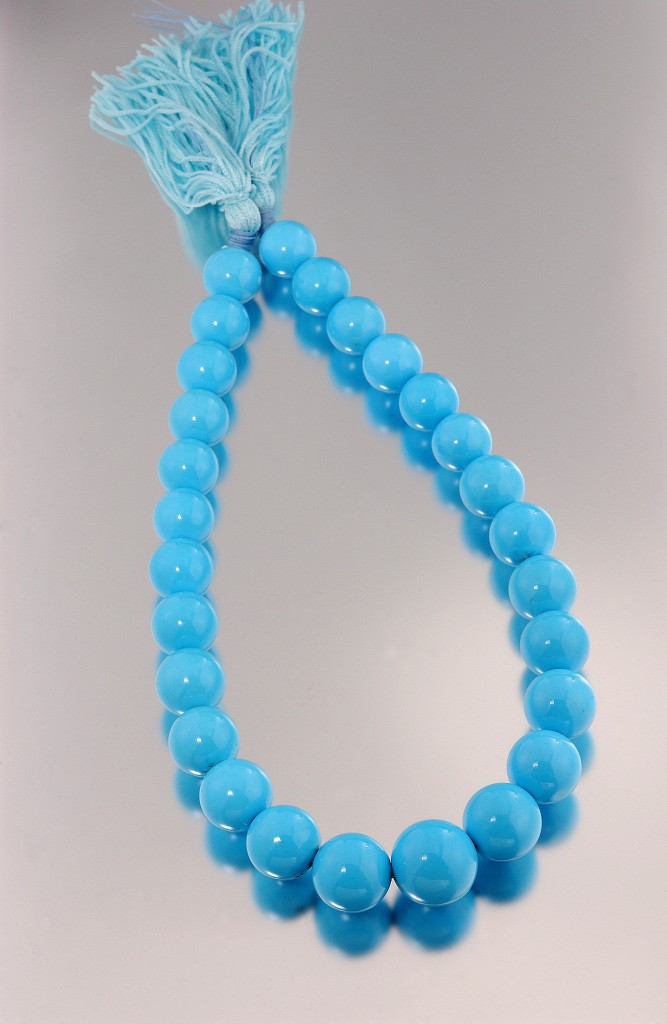 Turquoise is a phosphate (copper and aluminum) and has been used as an ornamental stone for centuries. It is opaque and valuable in its purest forms but it’s value has suffered in recent time as a result as a result of the availability of synthetic stones and treatments.
Turquoise is a phosphate (copper and aluminum) and has been used as an ornamental stone for centuries. It is opaque and valuable in its purest forms but it’s value has suffered in recent time as a result as a result of the availability of synthetic stones and treatments.
It is no harder than window glass and so is fairly fragile and got its name from “Turkish” as it first appeared in Europe from Turkey whose Ottoman Empire stretched East to the source of the stone, Persia. Over several hundred years the fine quality intense blue turquoise sourced from this region has resulted in the term “Persian Turquoise” being a definition of quality as opposed to the source of the gem.
Is Turquoise still in style?
Early Days
Turquoise was used as jewelry in the Ancient Persian and Egyptian Civilizations. It was used by the Persians for the domes of their palaces as well as other decorative items. In Egypt, the Tomb of Tutankhamen contained a good deal of turquoise used as inlay in the Pharaoh’s burial mask. If you have seen an exhibition of the Tutankhamen treasures, or even just photographs, you will see the amount of decorative blue in the exhibits.
Small amounts were used by the Chinese three centuries ago while the Aztecs of South America saw its decorative value as well. Its popularity in the West increased with the discovery of those Egyptian artifacts.
The wondrous Taj Mahal in Agra, India built by Shah Jahan as a memorial to his dead wife Mumtaz is another fine example of the use of turquoise. It combined with precious stones to make fine jewelry during the Moghul Empire in India.
In the US, Turquoise is most associated with the Navajo Tribe in the Southwest, with some ancient mines being discovered in that region.
Today
Turquoise Jewelry is a classic. Whether you purchase an estate piece or get one of the latest designs, it has a tendency to ‘light you up’ from within. It is often combined with yellow gold and with diamonds or emeralds.
How is Turquoise stone formed?
There is little common shape to turquoise; it is formed in areas of existing minerals with a good example being the deposits in the USA in regions associated with copper mining. You are more likely to find it in arid areas where it was formed after filling seams or veins. It is rare for it to be found at any great depth.
It is generally opaque but in thin layers can be semi translucent. It can even appear in an almost white form but generally it ranges between blue and green, with a yellowish tinge at times. The blue suggests the presence of copper, green of iron. In the USA it is often a secondary product from the prime activity of copper mining.
Its appearance can sometimes be enhanced by treatment but some deposits in the USA, especially in Arizona are of a quality where no treatment is necessary.
What are the properties of Turquoise?
Color : Blue, blue green, green
Crystal : Triclinic
Fracture: Conchoidal
Mohs scale: 5 – 7
Specific gravity: 2.6 – 2.9
For those interested in metaphysical properties, it is asserted that the turquoise gem stone is used for getting rid of negative energy. Its colors is associated with happiness, and is supposed to increase a person’s self confidence.
Is Turquoise gemstone treated?
Almost all recently manufactured Turquoise Jewelry contain a stone that is treated in some form or fashion. In the specific case of Turquoise, these are stabilization or impregnation treatments – these may sound complicated but they simply aim to which aim to Some of the treatment is meant to enhance the hardness or the density of the stone, and make it less porous. Without some of these treatments (which include paraffin or poly-resin polishes or some form of bonding agent), it is difficult to use fragile stones such as Turquoise in jewelry.
How To Care for Turquoise Jewelry?
Turquoise has decorative and jewelry uses but it cannot be worn as frequently as some other jewelry. It does not like direct sunlight and the color can fade if it is exposed to sunlight for prolonged periods. It is also sensitive to cosmetics and perfumes and this needs to be considered before putting on some turquoise for a day in the sun. The stone is porous and can absorb moisture, so always wear the piece after you applied your cosmetics. Turquoise jewelry needs regular cleaning with a soft cloth simply to avoid the buildup of anything on the surface.
It is an attractive stone for beads, and hence necklaces with the same proviso about its exposure to sunlight and fragility with cosmetics. The better turquoise is more towards blue than green. . Most turquoise has natural veins or fissures running through the stone, and this is a result of the ‘matrix’, the mother rock in which it formed. The better samples have a minimal amount of the matrix if any at all. Its color has made it a popular choice for many craft items as souvenirs or merely to decorate parts of the house, particularly when polished.
If cleaning at home, always use a soft white cloth or soft-bristled tooth brush, soaked in warm water. Make sure the piece has fully dried prior to putting it back into storage. Under no circumstances should you use high pressure steam or an ultra sonic cleaner to clean – in fact, if you are taking it to your local jeweler – make sure you ask how they plan on cleaning the item before handing your piece over.
CAN Turquoise Jewelry be scratched?
As mentioned above, Turquoise is somewhere between 5-7 in Moh’s scale of mineral hardness (by comparison glass is between 4-7). This means that whilst it is pretty robust, it can be scratched by items higher up in the scale. In terms of storage, you should wrap your piece in soft white (not colored or dyed) cloth, leather or place it in a felt pouch before putting it into your jewelry box or storage – because other stones (such as diamonds, sapphires and emeralds, which are higher up the Moh’s scale) can scratch the Turquoise gemstone.
Does Turquoise Jewelry Change color?
Turquoise jewelry does not change color under different lights. That said, it is quite a porous gemstone, so with use over time, the original color will change based on the extent and time the piece is worn and any stabilization treatments to the stone. This is natural and is part of what makes a gift of Turquoise jewelry truly unique and personal.
Many cultures regarded turquoise as a holy stone and one which gave protection. As a result there are many examples of its use that can be found in museums or depicted in drawings. It has lost its appeal at times but turquoise is a stone that keeps coming back into fashion and whenever purchasing make sure you pay special attention to the color as this most drives the price of the stone.
